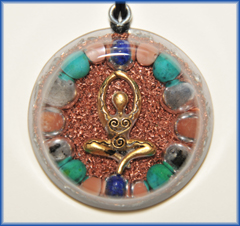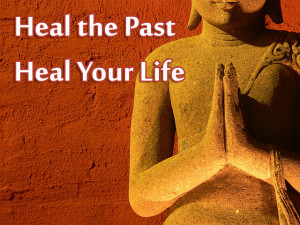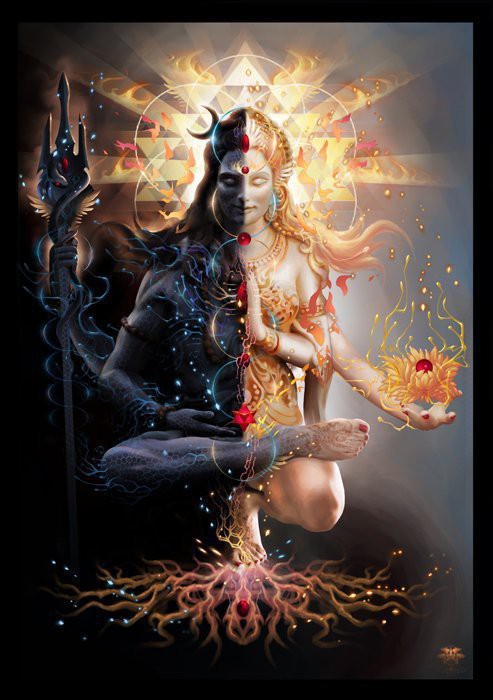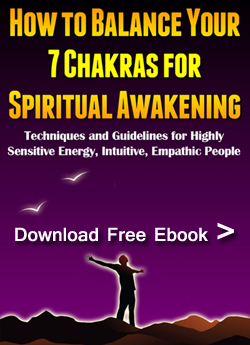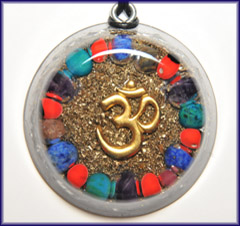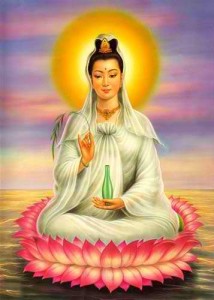
In my last Moon Transmission (Sept 2011– Pisces Full Moon) the energy of Kwan Yin was channeled. I have heard of this goddess before but never channeled or worked with her energy… In the Moon session the energy that was channeled was compassion.
I did some research about Kwan Yin and found this beautiful article:
Known as The Goddess of Mercy, Gentle Protectoress, Bodhisattva of Compassion, even the savior of seamen and fishermen, she holds many titles. The spelling of her name varies, but it is not so much the arrangement of letters as it is the effect that her spoken name produces on those with a Buddhist background, similar to a reaction in the West when one is speaking of the Virgin Mary. In both cases, it invokes the feeling of compassion and unconditional love. Indeed, her force is compared to Mother Mary in the West, Green Tara in the Tibetan culture, the Virgin of Guadeloupe in Mexico, and many other ancient goddesses, the matriarchy of old. You might call her the Buddhist Madonna, or, as She calls Herself, “The Mother of all Buddhas”.
By her own words, she is a complex energy presence. Thus, when asked her about her
incarnations as “Kwan Yin,” this involves many persons that have embodied and reflected this
energy in their lives on earth, as far as we can understand. According to Sucheta’s channelings,
the closest association of Kwan Yin being linked to a person energetically in recent times is Miao
Shan, an ancient Chinese princess who was known for her great compassion. Here is a quote
from Kwan Yin about this:
“Although I am Bodhisattva, I am energy. I am not a person. Basically, the Kwan Yin energy was
never in one single body. It has always been a great part of the energy of all of compassion of all
the Universe. What you see in front of you [Marjorie] is one person who has been able to tap in and
release for a period of time, so that she can let us be a part of her reality and to share that with you
so that you can be encouraged, and that you can also bring forward the part of you that knows the
truth.”
The name “Kwan Yin” is a derivation of a Chinese name for the goddess that is this energy of
motherly compassion. This is really a description of her energy (“she who hears the cries of the
people”) which has become accepted as her name on earth. Although there are variations, the
feeling is the same. She responds to the heartfelt needs and anguish of the people of earth
regardless of background or belief.
Being one of the “mother” goddesses, she is especially connected to those in need of any kind of
help, be they sick, lost, frightened or simply in unfortunate circumstances. She is a great protector
and benefactor of the weak, the ill and especially the children and the babies. Many erect alters to
Kwan Yin, the “bestower of children” — the one who hears the prayers of anyone wanting to
conceive a child — to increase their fertility. There is a connection with the care of souls, both during
birth and after death. Taoists invoke her presence to free newly departed souls from the judgement
of the underworld. She guards the souls of the newborn and guides them to their new parents.
Her range of influence is vast, from China to Korea and Japan, all the way down into Malaysia. She
has super-ceded her Buddhist traditions and jumped into the realm of a more universally
venerated goddess, now known to those of many different faiths and sects. Her image can be
found on most any alter of worship in temples, homes, schools, shops, restaurants, out of the way
grottos and even on the dashboards of taxis.
Entwined in the faith of Buddhism, her first real appearance in literature seems to be around 400
AD. By that time, Buddhism had been around for nearly 1000 years, spreading from its birthplace
in India to China, and subsequently to Korea, Japan and Tibet. Devotees of Avalokitesvara, or
Avalokita, Bodhisattva of Compassion of Indian Buddhism, brought the concept of Avalokita to
China. There, Avalokita, or Kwan Yin, was adopted as a god in the male form and later was
gradually changed by some to resemble a female, lending a rather androgynous element to her.
By 1200 AD she was definitely a female portrayed in flowing robes.
Avalokita is depicted with many arms, hands and heads, sometimes with an eye in each palm
representing the ever watchful omnipresent mother, ready to immediately reach out in any direction
to alleviate suffering. In Buddhist mythology, it states that Avalokita was born from Amitabha
Buddha’s right eye, after which he proclaimed, “Om Mani Padme Hum” — Hail to the jewel in the
lotus — a sentiment of her preciousness to him. Some believe she is actually an incarnation of
Amitabha Buddha. The Chinese translation of the Sanskrit Avalokita is Kuan shih Yin, the full form
of the shortened Kuan Yin, or Kwan Yin.
It is said in ancient writings that she was embodied as Miao Shan (whose name means
“wonderfully kind one”), a Chinese princess who lived about 700 BC. This legendary Buddhist
saint is said to have spent nine years living on an island off the coast of China, healing, meditating
and saving sailors from shipwreck. This island became a place of worship and pilgrimage for
many, especially in one of the caves there, which was transformed into a shrine dedicated to Kwan
Yin.
She is called a Bodhisattva, literally a “being of bodhi, or enlightenment.” Bodhi is the spiritual
energy that produces an urge for enlightenment, emanating Wisdom and Compassion. The
Buddhas are the primary stream from this energy, the secondary stream from the Buddhas being
the Bodhisattva. A Bodhisattva is any soul which has attained enlightenment and has freed itself
from the karmic cycle of rebirth, but which has forgone the bliss of Nirvana, the merging with the
Creator, in order to help all the rest attain their enlightenment. This is their vow. It is said that as
she was about to enter heaven, she paused at the threshold as the cries of the world reached her
ears, and she returned to help them. She is also called an Ascended Master, which essentially
means that one has learned all their lessons, transmuted their karma, and is not compelled to
experience being reborn into a physical body if they do not desire it.
In depictions she is shown with pearls of illumination in one hand; and with the other she pours
out “sweet dew”, the nectar of Wisdom and Compassion from a small vase, blessing all with
physical and spiritual peace. Her cupped hands are a symbol of the womb and the universal
feminine principal. She sometimes holds a sheaf of ripe rice, a metaphor for sustenance
supplied. The dragon is often seen with her, a symbol of wisdom, strength, and the power of divine
transformation. A Divine Mother, always there are children around her or being held by her. There
are two small attendants that show up periodically, a “young man of excellent capacities” and the
“daughter of the Dragon King,” both related to the legendary Miao Shan. As reference to fishermen,
sailors and water, she can be seen on a boat or a lotus flower crossing the sea, rising from the
sea on the back of a dragon. Other things related to her are a dove, a scroll of prayers which are
the teachings of Buddha, a rosary of white crystal beads showing the rounds of rebirth, and a
willow spray with which she sprinkles the divine nectar of life.
[constantcontactapi formid=”1″ lists=”1566209433″]
The Origin of Kwan Yin, or Miao Shan
There are many legends about the origin of Kuan Yin, but this in one of the most popular.
In 7th century China, a king had three daughters, the youngest named Miao-Shan. At the time of
Miao-Shan’s birth, the earth trembled and a wonderful fragrance and flower blossoms sprang up
around the land. Many of the local people said they saw the signs of a holy incarnation on her body.
While the king and queen were amazed by this blessing. Unfortunately, they were corrupt and saw
little value in a child who appeared pure and kind. When Miao-Shan got older, the king wanted to
find a husband for her. She told her father she would only marry if by so doing she would be able to
help alleviate the suffering of all mankind.
The king became enraged when he heard of her devotion to helping others, and forced her to slave
away at menial tasks. Her mother, the queen, and her two sisters admonished her, all to no avail.
In desperation, the king decided to let her pursue her religious calling at a monastery, but ordered
the nuns there to treat her so badly she would change her mind. She was forced to collect wood
and water, and tend a garden for the kitchen. They thought this would be impossible, since the
land around the monastery was barren. To everyone’s amazement, the garden flourished, even in
winter, and a spring welled up out of nowhere next to the kitchen.
When the king heard about these miracles, he decided that he was going to kill Miao-Shan. After
all, the nuns who were supposed to have tormented her. But as his henchmen arrived at the
monastery, a spirit came out of a fog of clouds and carried her away to safety on a remote island.
She lived there on her own for many years, pursuing a life of religious dedication.
Several years later, her father became seriously ill. He was unable to sleep or eat; his doctors
believed he would certainly die soon. As he was about to pass, a monk came to visit the king. The
monk told the king he could cure the monarch, but he would have to grind up the arms and eyes of
one free from hatred to make the medicine. The king thought this was impossible, but the monk
assured him that there was a Bodhisattva living in the king’s domain who would gladly surrender
those items if asked.
The king sent an envoy to find this unknown bodhisattva. When the envoy made the request,
Miao-Shan gladly cut out her eyes and severed her arms. The envoy returned and the monk made
the medicine. The king instantly recovered. When the king thanked the monk; he chastised the king
by saying, “You should thank the one who gave her eyes and arms.” Suddenly, the monk
disappeared. The king believed this was divine intervention and after ordering a coach prepared
headed off with his family to find and thank the unknown bodhisattva.
When the royal family arrived they realized it is was their daughter, Miao-Shan, who had made the
sacrifice. Miao-Shan spoke up, “Mindful of my father’s love, I have repaid him with my eyes and
arms.” With eyes full of tears and hearts full of shame, the family gathered to hug Miao-Shan. As
they did so auspicious clouds formed around Miao-Shan. The earth trembled, flowers rained
down, and a holy manifestation of the Thousand Eyes and Thousand Arms appeared hovering in
the air.
And then, the bodhisattva was gone. To honor Miao-Shan the royal family built a shrine on the spot,
which is known as Fragrant Mountain.
BODHISATTVA (also spelled Boddhisattva): Literally means “enlightened being”; a soul who,
through compassion and altruism, has earned the right to leave this world of suffering and enter
nirvana, but has chosen instead to stay on Earth to instruct others to until all beings are
enlightened. A Bodhisattva acts as the key figure in Mahayana Buddhism
http://www.mykwanyin.com/kwgoddess.html
[ctct form=”6018″ show_title=”false”]

